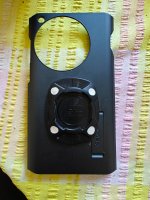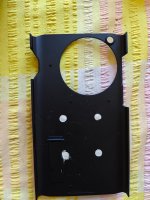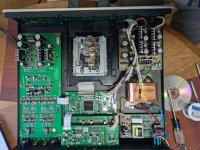My Vahalla 2701 DC voltage calibrator. Its essentially a 1KV DAC. One of the switches had frozen. The lube had turned to glue. I had replaced another one years ago but the BCD encoded switches have become harder to find and much more expensive. I tried several penitrating lubes which did nothing. However isopropyl managed to get the switch working again. I did a recal while it was open. Needed to move about 4 ppm.
For some reason there is no bypassing on the logic (rooky mistake?) but changing that would probably open issues requiring a full recalibration so I'm letting it ride.


For some reason there is no bypassing on the logic (rooky mistake?) but changing that would probably open issues requiring a full recalibration so I'm letting it ride.
I have a pair of Data Precision 8200 calibrators. Trimmers have gone intermittent (noisy). Handy when they work, but all trimmers need to be replaced and then it needs calibration.
Similar to your Vahalla calibrator. I used these in the calibration lab as well as a Vahalla, can't remember the model but it was different than yours.
Similar to your Vahalla calibrator. I used these in the calibration lab as well as a Vahalla, can't remember the model but it was different than yours.
I've been needing to check out and recommission our invisible fence as It's been powered down for a few years and we have new foster dogs. The box was full of cobwebs and the wall wart transformer had taken on water, so I removed the control board and carried it to the shop. I apparently hadn't paid any attention when I installed it but the 4 pin DIN connector on the wall wart caught my eye. This is the first dual output unit I've run across. 12V/12V
I pulled the cover off of the control and things looked mighty familiar. A bipolar supply feeding a pair of LM1875 's. Its just a chip amp at heart. Of course it needs an amplifier, but this isn't what I was expecting. Maybe I'll leave it on the bench and play with the scope to learn something until I get to fault finding and repair of the
1500' loop.

I pulled the cover off of the control and things looked mighty familiar. A bipolar supply feeding a pair of LM1875 's. Its just a chip amp at heart. Of course it needs an amplifier, but this isn't what I was expecting. Maybe I'll leave it on the bench and play with the scope to learn something until I get to fault finding and repair of the
1500' loop.
Not DIY hifi, but I nearly lost my phone down a cattle grid when the sticky on the quadlock mount failed while cycling over it. It missed the grid by less than a metre.
The Spigen case for my Oneplus12 is not entirely smooth and even 3M VHB won't stay stuck.
Cleared off the old VHB, drilled and countersunk 4x 3mm holes through the quadlock mount and the hardshell case. Restuck with new VHB, then used sugru epoxy putty through the holes to secure the whole thing.
So far so good. I like sugru, though milliput is also excellent, I've repaired tiles and tons of broken pots with milliput.
The Spigen case for my Oneplus12 is not entirely smooth and even 3M VHB won't stay stuck.
Cleared off the old VHB, drilled and countersunk 4x 3mm holes through the quadlock mount and the hardshell case. Restuck with new VHB, then used sugru epoxy putty through the holes to secure the whole thing.
So far so good. I like sugru, though milliput is also excellent, I've repaired tiles and tons of broken pots with milliput.
Attachments
I built up a model railway DCC shuttle controller.
It seemed to power up ok as it flashed the LED.
However it wouldnt move the loco on the track.
Checked signal to track and that was there.
Checked power supply and speed and timer controls were working.
So made software output a 10KHz signal to the track.
It came out a none square signal.
Turned out to be unsoldered pin on motor driver IC.
The VCC pin wasnt soldered.
It seemed to power up ok as it flashed the LED.
However it wouldnt move the loco on the track.
Checked signal to track and that was there.
Checked power supply and speed and timer controls were working.
So made software output a 10KHz signal to the track.
It came out a none square signal.
Turned out to be unsoldered pin on motor driver IC.
The VCC pin wasnt soldered.
Rebuilt the topside of a damned toilet that had developed a leak between the bowl and the tank.
I'd love to say that's where I draw the line plumbing wise but I guess that depends on the $$$-quote if anything goes wrong below the poo line.
I prefer machinery and electrical/electronics
I'd love to say that's where I draw the line plumbing wise but I guess that depends on the $$$-quote if anything goes wrong below the poo line.
I prefer machinery and electrical/electronics
I have a musical fidelity The Pre Amp on the bench. Down one channel and offboard psu is skewed 4v +/-
Last serviced 1989..
Needs a new relay in the pre and recap of the psu.
Last serviced 1989..
Needs a new relay in the pre and recap of the psu.
My Philips PM 3070 oscilloscope.
The wonderfully cheap (and very non-standard) Phier power switch fell apart. It solders directly on the power PCB. A standard DPDT switch had to be heavily modified to fit. Then I found previous service had shredded a flat ribbon cable, 10 pin. Making a new one restored some front panel functions.
It's a really great oscilloscope that will die again due to cheap manufacturing and parts. Way to go Philips!
The wonderfully cheap (and very non-standard) Phier power switch fell apart. It solders directly on the power PCB. A standard DPDT switch had to be heavily modified to fit. Then I found previous service had shredded a flat ribbon cable, 10 pin. Making a new one restored some front panel functions.
It's a really great oscilloscope that will die again due to cheap manufacturing and parts. Way to go Philips!
lol!
I bought that scope brand new, when they first came out. I wanted an HP, but they had gone digital (54600?, a blunder for HP in my view). Early digital scopes were not very good. I even had a "Norland Prowler" digital "scope". It was useful for select things. The Tek product wasn't very good in comparison. The Philips products had the very best display and still does. I have an earlier HP analogue scope that I liked very much.
Anyway, back then I had no idea Philips had become so cheap. Early Philips scopes I owned were very good. The only reason I fixed the Philips is that it really does have the best display, sharp and very clear.
I bought that scope brand new, when they first came out. I wanted an HP, but they had gone digital (54600?, a blunder for HP in my view). Early digital scopes were not very good. I even had a "Norland Prowler" digital "scope". It was useful for select things. The Tek product wasn't very good in comparison. The Philips products had the very best display and still does. I have an earlier HP analogue scope that I liked very much.
Anyway, back then I had no idea Philips had become so cheap. Early Philips scopes I owned were very good. The only reason I fixed the Philips is that it really does have the best display, sharp and very clear.
Phier is a component manufacturer, in Spain I believe.
Piher 🙂 at least here.
I probably mis-spelled it. I find their products are very failure-prone. This switch simply furthers that reputation. Never mind it is a completely non-standard type of switch that Philips decided to design into the power supply PCB. Stupid.
Piher…. Whenever you had a European made audio device in the eighties/nineties and it had crackling volume control this was the name you read on it.
- Home
- Member Areas
- The Lounge
- What did you last repair?


